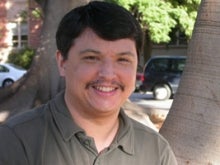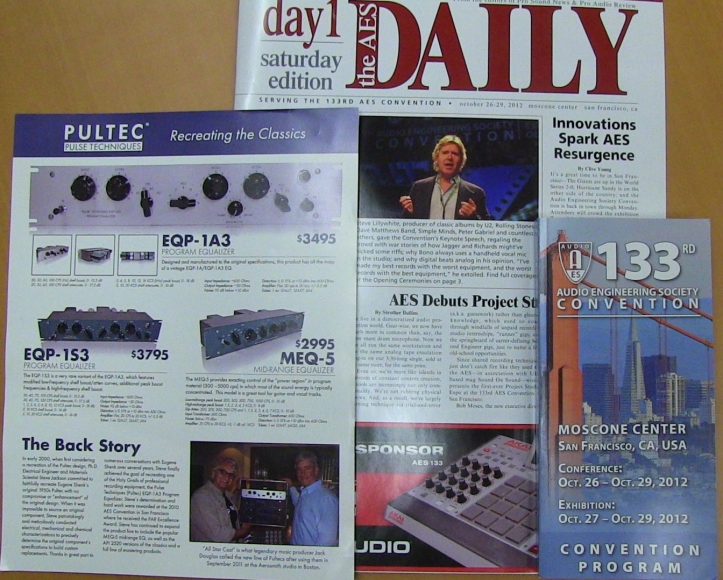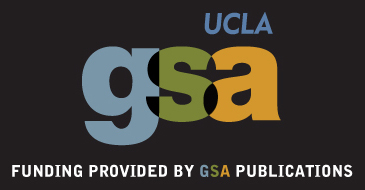Audio Engineering Society (AES) Convention 2012

This week's guest columnist is Ethnomusicology's David Martinelli. --Maureen
A few weeks ago, Professor Rees told me the department had some funding to send me to a conference, and asked me to give her a list of ones I would be interested in attending. When I gave her the list, at the top was the Audio Engineering Society (AES) Convention in San Francisco. Professor Rees approved, Jennie and DJ worked out the details of registration and flight, and on Thursday October 25 off I went.
Beforehand, I looked over the convention schedule on the AES website to see what was being offered. There were numerous panels and workshops on several topics of interest, so many that I had to miss several potentially interesting ones. In the end, there were three days packed from 9 to 6, one great session Monday morning, a screening of a great documentary, and a fun exhibit hall.
Getting there was fantastically easy. It involved a one hour flight from Burbank to Oakland, a ride on the Air Bart shuttle ($3), and a 25 minute ride on the BART train ($3.85) to the station in San Francisco that literally let out at the front door of my hotel. The hotel was located about 10 minutes away (on foot) from the convention center.
Given the vast variety of audio-related topics being presented, I tried to focus on things relevant to my job here, but since my job here is such a catch-all, almost anything I went to could have been considered relevant. Of most value to me were the sessions that discussed things related to specific processes, rather than those dealing with theoretical background issues, mainly because the latter involved so much technical jargon that they went right over my head (my background is in music, not electrical engineering).
I also attended a meeting of the Archiving, Restoration, and Digital Libraries Technical Council. By attending this meeting, and writing my name and e-mail address on a piece of paper that was passed around, I became a member of this committee. The main topic of conversation at this meeting was planning a mini-conference or some other kind of get together to discuss issues of interest to this group. Hopefully this will come together at some later date.
The panels I attended focused on such topics as sound and mobile devices, AC bias and magnetic tape (one of the ones that were too technical for me), audio encoding and streaming, streaming over radio and mobile devices, the loudness wars, and issues dealing with lossy audio encoding.
The best presentations for me were the following:
Chuck Knowledge gave a presentation that detailed the system he uses for live sound, mainly with the electronic group Nero. He went step by step on the equipment he uses, the rationale for using such equipment, and some of the issues he had to overcome. It was a very forward-looking approach to doing live sound, but tailored to a specific style of music; nevertheless, there were several great ideas presented for new ways of doing things, and it makes the current way of doing live sound seem so antiquated.
UCLA Ethnomusicology alumnus Nicholas Bergh gave a fascinating presentation on the history of recording at RCA studios from 1925-1953. Through extensive research, he presented what equipment was used and how this equipment changed over the years. Most interesting to me was the equipment that was used between the mic and the disc cutter; this was something I previously had no idea about. He also presented a recording he made using restored versions of this exact same recording chain, and it sounded really good!
A session entitled Today’s Audio Delivery Formats focused on some different approaches to current sound recording formats. Stefan Bock of MSM Studios demonstrated an audio Blu-Ray disc that would play high-resolution audio files (either 2-channel or surround) on standard Blu-Ray players. Robert Bleidt from Fraunhofer demonstrated the best way to get good sounding compressed audio files, and demonstrated the new Sonnox Frauenhofer Pro-Codec software. The session ended with Bob Katz presenting some caveats regarding lossy coding.
A session on the perceived benefits of upsampling, The Controversy over Upsampling—Boon or Scam, included a presentation by Bob Katz where he described his mastering process, which was extremely informative. The other presenters on this panel delved into technical issues that went right over my head.
Bill Whitlock, president of Jensen Transformers, had a great presentation on Audio System Grounding and Interfacing. This went over the issues involved in finding and preventing noise from entering into audio systems. A lot of it was electrical engineering 101, but since I’m not an electrical engineer this information was very useful. I downloaded the 212-slide power point presentation of this session and look forward to going over it.
Mastering engineers Bob Ludwig, Eric Boulanger, and Bob Katz (again) presented a fascinating and extremely relevant session on Platinum Mastering for Itunes, where they detailed what it is, what the process involved is, and some of the issues with it.
I stayed an extra day to see the Monday morning presentation by Nadja Wallaszkovits of the Phonogrammarchiv in Vienna on the challenges of transferring reel to reel tape to computer. Since this is the same thing I do at the Ethnomusicology Archive, I was interested to see what her processes were, and what issues she had to deal with. Especially interesting was their process of recovering acetate tapes. For those of you who don’t know, acetate tapes can dry out over the years, releasing a vinegary smell, curling up, and breaking, which makes them difficult if not impossible to transfer. The Phonogrammarchiv has developed a system of chemically restoring these tapes so they can be transferred.
An extra treat was a screening of Denny Tedesco’s film The Wrecking Crew, his documentary about the legendary group of Los Angeles studio musicians who anonymously contributed to many of the hits of the 1960s, including those of the Beach Boys, Sonny and Cher, The Monkees, and our own Herb Alpert, among many others. Included were interviews with the above artists and wrecking crew members Hal Blaine, Carol Kaye, Tommy Tedesco, and Plas Johnson. The film was also full of great music, which is the reason why it has not been widely distributed, as getting releases from the record companies is a very expensive, ongoing process.
The exhibit hall was fun too. It was interesting to see the resurrection of classic audio gear, such as Pultec equalizers, Telefunken microphones, and recreations of Neve 1073’s and Fairchild compressors in hardware form. Going in the other direction, Eventide was showing their native software version of the H3000. Of interest to ethnomusicologists were field recorders made by Sound Devices and Nagra.
The best part about going to this convention was getting information directly from people with extensive hands-on experience with audio, whose livelihoods and professional reputations depend on their giving accurate information. Sometimes I am tempted to go to an internet forum to get information about audio equipment, or how to do something, only to be confronted with postings by anonymous people with poor communication skills, whose postings are so vague as to be completely useless, or who just give flat out wrong information. As Bill Whitlock noted, wrong information can literally be lethal. Unlike anonymous internet posters, the audio professionals at the AES are accountable for what they say, and award-winning classic recordings and great sounding live shows are proof that they know what they’re talking about.






